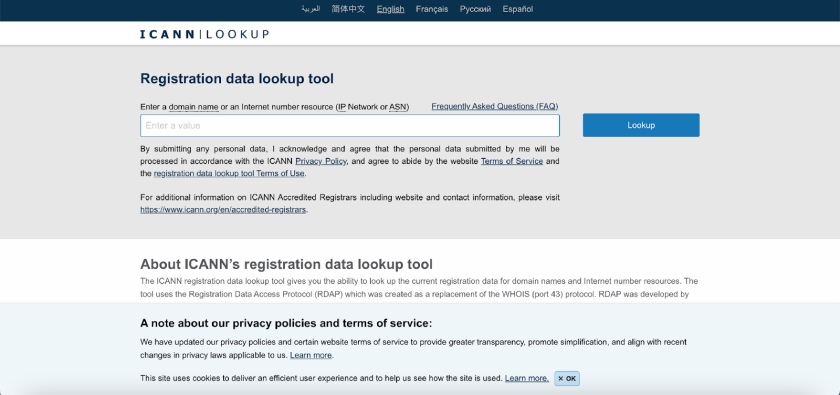Understanding how to trace a voice-over-internet-protocol (VoIP) number is essential for data security, customer callback, and system monitoring. Our guide covers five effective methods for tracking VoIP numbers and identifying the origin of these internet-based calls. It also outlines VoIP security best practices to keep your communication stack secure.
1. Search Using Reverse Number Lookup
One effective way to trace a VoIP number is to do a reverse VoIP number lookup. To retrieve caller information, simply enter the phone number into a specialized search database or tool like Truecaller or Searqle.
This process provides details such as the caller’s name and location. This is the opposite of traditional phone book searches, where you search for a person’s phone number using their name; instead, you search for a person’s name using their number.
To illustrate how to trace a VoIP number using this method, let’s take a look at Truecaller as an example. This caller ID app offers reverse phone lookup tools that enable you to identify who called you by entering the caller’s number.
The search yields information like the owner’s name and location. This platform is one of our recommended best call blocker apps because it tells you if the caller is a spammer and allows you to block the VoIP phone number and caller.
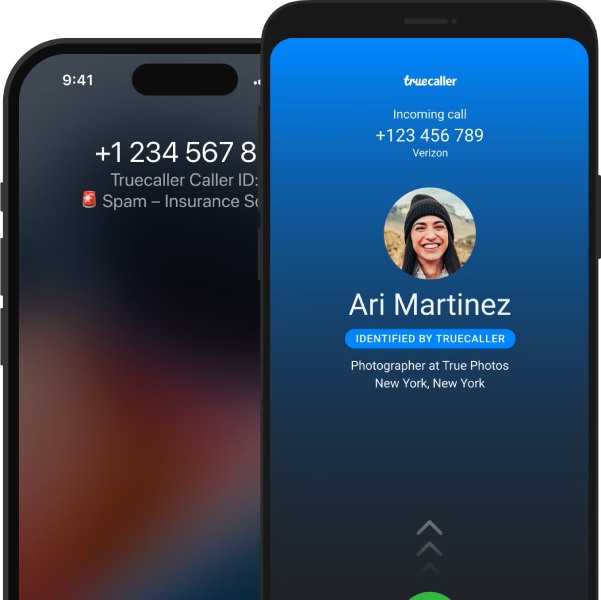
Truecaller’s caller ID feature detects and identifies domestic and international phone numbers. (Source: Truecaller)
Here’s how to trace a VoIP phone number by scanning it using Android phones:
- Click on the Truecaller search bar.
- Tap the search icon found in the upper right-hand corner.
- Follow the instruction: “Point your camera at any phone number to search in Truecaller.”
- Wait for the scanner to detect the number and complete the search.
- Note the results.
Steps to trace a number using the Truecaller website:
- Go to the Truecaller website.
- Sign in or create an account using your email address.
- Once logged in, enter the phone number you’re looking for in the phone number search bar.
- Enter the phone number and wait for the results.

Truecaller’s reverse phone lookup tool allows you to find out who called you instantly. (Source: Truecaller)
This method is one of the simplest ways to trace a call, as it doesn’t require installation or downloads, and several providers also offer this service for free. However, you may not get all of the exact information you want because VoIP numbers are not always fixed to a specific user, meaning they may not be associated with a single person or location. These numbers may be reassigned and used by different individuals or devices.
Additionally, some providers can only provide details on US numbers, limiting the ability to trace overseas callers. While VoIP flexibility allows users to make and receive calls from anywhere, it complicates tracing the exact origin or identifying the current user of the number.
2. Inspect Call Detail Records & Logs
When learning how to trace VoIP calls, you can refer to call detail records (CDRs) provided by your network administrator or VoIP service provider. CDRs often include essential information, such as the date, time, call duration, IP addresses, and caller ID of incoming and outgoing calls and messages. Reviewing these records, as well as your call history and network logs, helps identify the source and destination IP address of calls.
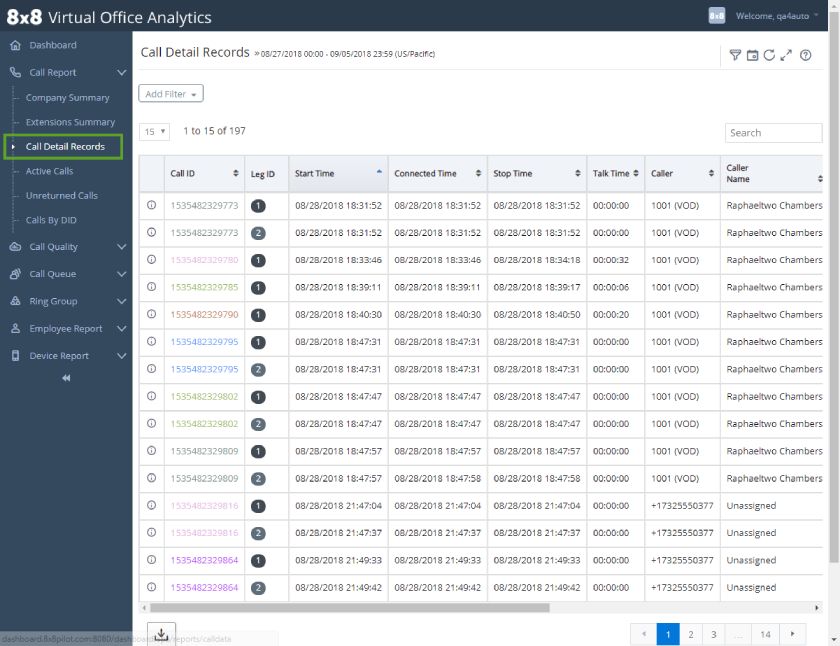
8×8’s call detail records show the entire call journey from start to finish. (Source: 8×8)
Cross-referencing call details with other available data, such as network traffic and call logs, offers insights into the VoIP call’s origin.
For example, if your business has received a series of fraud calls from different numbers, CDRs can reveal patterns like common IP addresses and call times. These details can pinpoint location, help mitigate fraud, and improve security protocols.
3. Perform an IP Address Lookup or Domain Search
If you have the domain name associated with the IP address, you can check domain names and IP addresses. Performing an IP address and domain search provides concrete and actionable data, tracing a caller’s specific geographic location or internet service provider (ISP) or the identifying contact information of the domain owner and other helpful registration data.
Follow the steps to learn how to trace a VoIP number through IP addresses and domains.
- Access CDRs to identify the IP address: Get your CDRs from your VoIP or network administrator and use these records to locate the IP address associated with the VoIP number you want to trace.
- Perform an IP address lookup: Use an online IP lookup tool like NordVPN or ICANN Lookup to get geolocation information, including the approximate location and ISP of the IP address.
- Do a domain search: Armed with the IP address and location, use a WHOIS lookup tool This refers to an online service that enables users to retrieve information about registered domain names. like GoDaddy to get information about the domain, including the owner, registration details, and contact information.
Completing an IP address lookup generally takes a few minutes, depending on the tools used and the speed of your internet connection. Once you have details regarding the network from where the call originated, you can contact the ISP or service provider for further assistance.
Challenges arise if the caller uses a nonfixed VoIP number, different numbers share the same IP address, a VPN is in use, or the number isn’t registered accordingly.
VoIP phone systems like Nextiva allow you to find a call’s domain address In the context of VoIP, this refers to the network domain associated with the IP address from which the call is made or received. It often indicates the internet service provider (ISP) or the organization hosting the VoIP service. through your VoIP dashboard. Access your call details and history, including details like call time and duration, the caller’s name and number, and their IP domain.
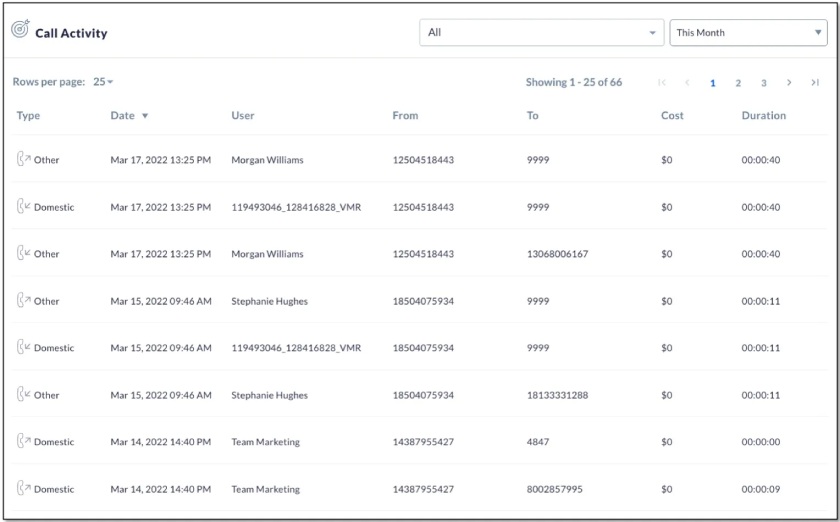
View your call history reports using NextOS and see call information like the call date, user, and duration. (Source: Nextiva)
Nextiva is a leading VoIP communications provider and our recommended VoIP softphone solution, thanks to its feature-rich business phone system and powerful team collaboration app. To learn more about this platform, read our comprehensive Nextiva review to see if this provider is right for your business.
4. Dial *69 (Call Return)
Businesses often seek to track a VoIP number to reconnect with callers they may have missed. Dialing *69 connects you to an automated service that provides the details of your last caller, including the time, associated VoIP number, and call origin.
Simply dial *69 and press the call button on your device’s keypad to retrieve missed call details. The service will automatically dial your most recent incoming call. Once you initiate the *69 callback feature, the recipient’s phone will ring, showing your caller ID display.
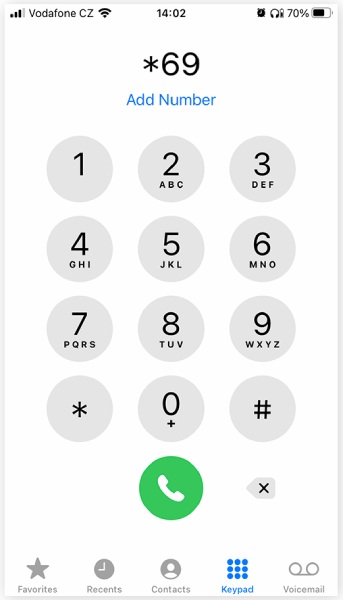
Dial *69 for the last number of your last incoming call. (Source: Avast)
In the United States, the code *69 is widely used and is provided by most telephone service providers. However, *69 may not be available in certain regions, and it may function differently, depending on your area and service provider. Using this feature might incur a small fee, and *69 may not work if callers use *67 (ID blocking) to call you.
5. Coordinate With Law Enforcement
In serious situations like fraud, scams, and cyberattacks that require VoIP call tracing, law enforcement organizations, such as the Federal Communications Commission (FCC), and police cybercrime units, use specialized tools and resources to track these calls. They analyze network traffic, collaborate with security experts, and use cross-reference data to obtain call records and uncover the caller’s identity.
Working with authorities on communication-related concerns that impact your business ensures suspicious and malicious VoIP calls are traced and addressed legally. Law enforcement agencies have the legal authority to obtain call records crucial for accurate tracing and have established networks for tracing across borders and jurisdictions, ensuring compliance with legal and regulatory standards.
VoIP Security Best Practices
Proper VoIP technology and data security management ensure reliable communication, confidentiality, and customer trust. It minimizes costly data breaches. While learning how to trace VoIP calls is crucial for monitoring, implementing best practices and strong data security standards is equally important. There are five key practices to protect business and client information, enforce secure access controls, and enhance employee training.
- Set up caller ID: Modern smartphones and desk phones have caller ID features, which display incoming names and phone numbers. Activating caller ID minimizes business caller spam and fraud by filtering out unwanted or suspicious calls.
- Monitor regular VoIP traffic: Early detection prevents potential security threats. Have your network administrators or IT staff regularly monitor VoIP traffic and call logs to identify unusual or suspicious call patterns immediately.
- Train your staff: Educate staff on cybersecurity, including topics on secure data handling, phishing scams, and call tampering. Emphasize information confidentiality, immediate reporting, and constant vigilance. Consider learning opportunities like VoIP training certifications and courses to improve productivity, customer service, and technical proficiency while maximizing the benefits of VoIP technology.
- Secure your system: Use all the tools available to boost the strength of your phone system, including encryption, strong passwords, and multifactor authentication. Using multiple layers of security makes it harder for malicious actors to exploit your communication infrastructure.
- Back up your data: Institute a routine schedule for backing up vital business information to mitigate data loss from cyberattacks, hardware malfunctions, and system failures.
Frequently Asked Questions (FAQs)
VoIP calls are routed over the internet by converting voice signals into digital data packets sent over the internet from the caller’s internet service provider (ISP). The packets navigate through routers and networks using the most efficient path determined by internet routing protocols. Upon arrival at the recipient’s ISP, the packets are reassembled and converted back into voice signals.
Tracing VoIP calls poses challenges due to the dynamic nature of virtual phone numbers, data encryption, and IP addresses. To address these challenges, implement advanced CDR analysis and work with your VoIP service provider to access call logs and information. Use network monitoring tools to detect suspicious activity and mitigate cybersecurity issues.
Based on our review of various VoIP solutions, we recommended RingCentral, Nextiva, and 8×8 because they offer robust data protection tools like extensive security compliance certificates, network monitoring, and secure user access features.
Bottom Line
Tracing VoIP calls can be complex, but using the right methods and tools, such as phone number and IP address lookups, can effectively identify call origins and enhance your security measures. The techniques outlined in this guide will help you address potential threats and ensure reliable communication.
Tracing VoIP calls involves capturing and analyzing call data to identify the origin and path of the communication. But learning how to trace VoIP calls is only part of the solution. It’s equally important to secure your system with essential VoIP business tools like ring groups and implement security best practices like encryption and access controls. Integrate these approaches to protect your phone system from potential threats.
